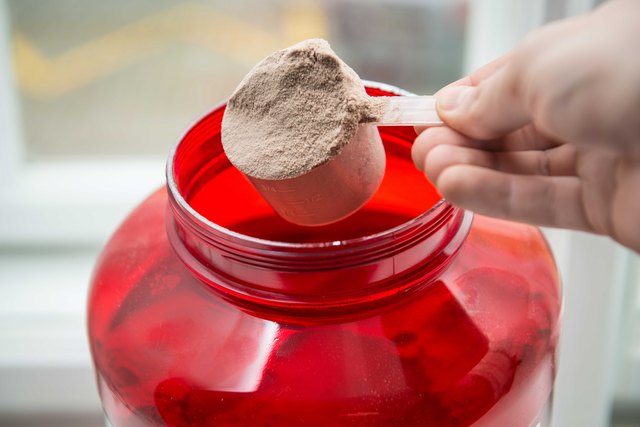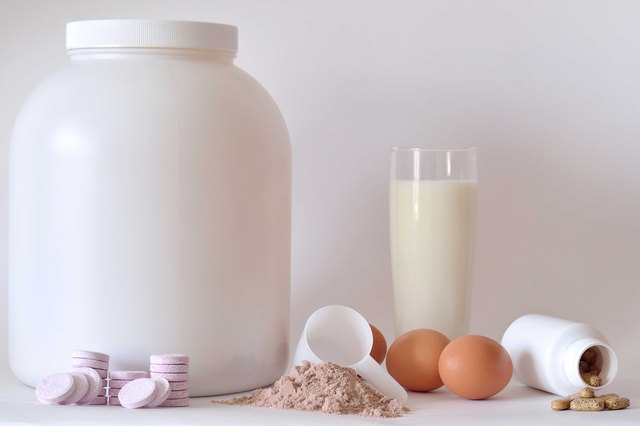
Is your goal to lean out or get swole? Maybe you’re just trying to get your daily dose. Whatever your reason for taking protein powder, it’s important to know what you’re putting down the hatch. Have you ever wondered what’s in your protein powder —like, really, really in it — not just the amount of protein, carbs and fat?
Protein powders aren’t strictly regulated by the FDA: Companies operate on more of an honor system, so there’s more leeway for lower-quality products like cheap proteins, fillers and unnecessary additives to make their way in. In more serious instances, harmful levels of heavy metals (mercury, arsenic and lead — no thank you) and even banned substances have been detected.
Keep Your Protein Powder Honest
So what can you do? First, look for third-party certification. An “Informed Choice” certification guarantees the product is free of banned substances and a seal of approval from another third-party — NSF International and United States Pharmacopeia (USP) being the most popular — verifies that the supplement contains what it says it does in the amounts claimed. Also, peruse the ingredient list and know what to look out for. (This is where we come in.)
Here’s a close look at 12 common protein powder ingredients, both good and not-so-great, and what you need to know before getting in the checkout line.
1. Whey Protein
The most popular source of protein found in big, plastic tubs, whey comes from milk and contains all of the nine essential amino acids, making it a complete protein. This is a good thing. The most common types of whey include isolate, concentrate and hydrolyzed.
WHAT TO LOOK FOR: You want whey to be at the top of your ingredients list, and choose a product that is rBGH-free. If your budget allows, go for certified USDA organic, grass-fed powders. Also, if you’re lactose intolerant you may do better with whey isolate because it contains less lactose.
2. Animal Protein (Whey-Free)
If you’re lactose intolerant or just prefer not to do whey, egg white protein and gelatin protein are two dairy-free options. Casein protein is also whey-free. Like whey, it’s derived from milk, but it tends to make protein shakes much more thick and is digested and used by the body much more slowly, says Jason Powell, Ph.D., member of Team Optimum Nutrition. “It is commonly used as a nighttime supplement among strength athletes and bodybuilders to aid in curbing their appetites over the entire night,” adds Powell. However, since it is slow-moving, it can cause problems in people who already have issues with constipation, says sports dietitian Georgie Fear.
WHAT TO LOOK FOR: Although less common, organic and GMO-free egg white powders and grass-fed, pasture-raised gelatin versions are available.
3. Plant-Based Proteins (Pea, Hemp, Rice, Etc.)
If you follow a plant-based diet or are simply trying to cut down on your consumption of animal products, plant-based proteins can be an easy way to get more protein in your diet. Dietitian Georgie Fear recommends trying different kinds to find the right flavor for you.
WHAT TO LOOK FOR: Choose protein powders that contain protein from multiple sources (e.g., pea, hemp and rice) to help increase the variety of essential amino acids that you’re getting, recommends Cliff Edberg, RD, national education manager of nutrition, metabolism and weight management at Life Time Fitness.

4. Lecithin
Soy and sunflower lecithin are common emulsifiers you might see on an ingredient list in whey protein options (it’s less common in plant-based powders). They are tasked with the job of helping the powder dissolve more easily in water, milk or whatever other liquids you include in your shake. After all, no one likes to drink a chunky protein shake. Emulsifiers don’t alter your protein powder’s nutritional profile or taste.
WHAT TO LOOK FOR: If you have a soy allergy, pick a soy-free option, and choose an organic powder if avoiding genetically modified soy is important to you.
5. Gums and Other Thickening Agents
“As the name implies, these are included to give the powder a thicker consistency when it’s mixed up with water or milk. Common thickeners include guar gum, locust bean gum, xanthan gum, carrageenan and maltodextrin — and none are animal-derived, so they’re vegan,” says dietitian Georgie Fear, author of Lean Habits for Lifelong Weight Loss. Although they’re starches, they aren’t used in enough quantity to add a significant amount of carbs or sugar to your protein shake.
WHAT TO LOOK FOR: Most of these thickeners are relatively benign although if you're trying to avoid them altogether, there are products available in the market. The CSPI gives carrageenan a "caution" rating however, especially for those with a history of GI issues. And while the FDA and World Health Organization claim that the small amount found of carrageenan food does not pose a health risk, other departments are concerned with the degraded form (found in small amounts in food) being possibly carcinogenic in humans.” Also, if you’re gluten intolerant or have celiac disease, make sure your powder doesn’t use wheat or gluten as its thickening agent, advises dietitian Cliff Edberg, national education manager of nutrition, metabolism and weight management at Life Time Fitness.
6. Sugar Alcohols and Artificial Sweeteners
If you’re looking for extra protein without all the carbs, make sure you’re reading the nutrition facts panel and ingredients list before purchasing. To keep powders palatable but the sugar content down, sugar alcohols and artificial sweeteners are typically added. You can find them listed in the ingredients list under one of their many aliases including: mannitol, sorbitol, xylitol, hydrogenated starch hydrolysate and erythritol for sugar alcohols and sucralose, aspartame and saccharin for artificial sweeteners. Stevia is another common ingredient that is considered a novel, more “natural” sweetener. “Many people using protein powder are seeking the added benefits of muscle recovery while pursuing or maintaining a lean frame. Unnecessary added sugars can interfere with those goals,” says dietitian Cliff Edberg.
WHAT TO LOOK FOR: The Center for Science in the Public Interest recommends cutting back (limiting) the amount of sugar and sugar alcohols and to completely avoid aspartame and sucralose. Shop for an unsweetened powder or one that uses stevia. In some people, sugar alcohols, including mannitol and sorbitol, may cause an upset stomach, bloating and gas. Remember, you can always sweeten your protein shake with a single serving of fruit or berries.
7. Natural and Artificial Flavors
From “cookies and cream” to “cinnamon roll,” protein powders can take on almost any flavor, and to accomplish this while keeping the calorie and typically sugar content down, natural or artificial flavors are added. Flavors aren’t simple and in many cases can contain more than 100 different chemicals. Natural flavor means it’s derived from an animal or plant; artificial flavors are made in a lab. According to the Environmental Working Group, however, there’s little difference between the two.
WHAT TO LOOK FOR: The chemicals used in both natural and artificial flavors isn't specified on the label so if you have allergies, especially to MSG or MVP, you may want to avoid. Or, if you’re just concerned about natural or artificial flavors altogether, your best bet is to look for an unflavored powder. Or try turning to your own kitchen cupboard or refrigerator to add some flavor, says Jason Powell, Ph.D., member of Team Optimum Nutrition. Think banana, peanut butter or cinnamon.

8. Oils and Fats
“Fat sources like safflower oil, cotton seed oil, soybean oil, canola oil and MCT, or medium-chain triglycerides, are commonly added to ‘weight gainer’ formulas to increase a protein powder’s caloric density, but are kept to a minimum in protein powders that aim to keep protein high and everything else low,” says Georgie Fear, RD, author of Lean Habits for Lifelong Weight Loss.
WHAT TO LOOK FOR: Avoid any refined oils or trans fats on the label. They can spur inflammation and degrade the integrity of cells throughout your body, says Cliff Edberg, RD, national education manager at Life Time Fitness.
9. Artificial Colors
With names like Green 3, Red 40, and Yellows 5 and 6, it’s obvious that these colors are anything but natural. And experts agree: They are best avoided. “These unneeded ingredients are added to protein powders to deceive the consumer to see the product as more appetizing or healthy,” says dietitian Cliff Edberg. “For some, these artificial ingredients may be highly allergenic, and some studies suggest a connection to hyperactivity.” Without the coloring, your protein powder may not be as pretty. But it’s well worth the trade-off.
WHAT TO LOOK FOR: There are so many available protein powders that are free of fake colors, so choose those whenever possible. Some brands use natural foods like beets for coloring.
10. Supplements
There are tons of different nutrients, enzymes and recovery and ergogenic aids added to protein powers to increase the nutrient density, increase customer results and improve digestibility, says Cliff Edberg, RD, national education manager of nutrition, metabolism and weight management at Life Time Fitness. For instance, you might see creatine, digestive enzymes, calcium or vitamin A palmitate on your ingredients label.
WHAT TO LOOK FOR: “They are probably not something you need to seek out, but they also shouldn’t be a detractor as long as they don’t contain mega-dose amounts,” says sports dietitian Georgie Fear.
What Do YOU Think?
Have you seen any of these ingredients on your protein powder label? Will you be looking out for any of them in the future? Are there any ingredients we didn’t mention that you either love or hate?
No comments:
Post a Comment